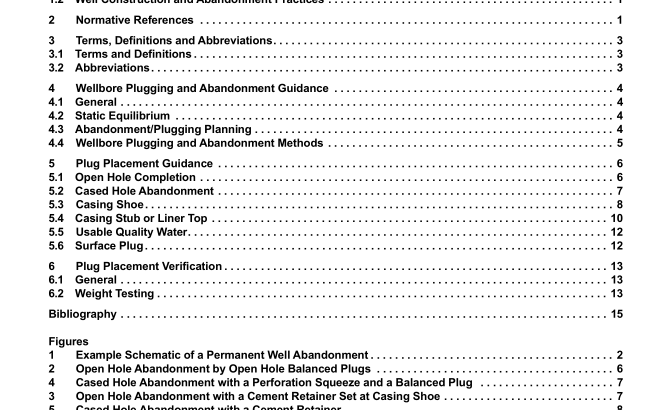API Bull E3:2018 pdf free download.Wellbore Plugging and Abandonment Practices
4 Wellbore Plugging and Abandonment Guidance
4.1 General
This section provides guidance on procedures for plugging and abandoning a well. The procedures involve setting cement plugs or other barriers at critical intervals to prevent the wellbore from becoming a conduit for fluid migration.
The primary objectives of a well abandonment operation are protecting usable quality water and isolating potential flow zones. The plugging and abandonment procedures provided in this document focus on the following objectives:
a) protecting usable quality water from contamination by formation fluid migration or surface water runoff;
b) isolating potential flow zones (e.g. reservoir hydrocarbon zones, shallow gas, over-pressurized water zones) unless cross flow is deemed acceptable;
c) protecting surface soils and waters;
d) isolating injection/disposal zones (e.g. water, carbon dioxide, cuttings re-injection).
These objectives are accomplished by placing cement or mechanical plugs, or both, at selected intervals in the wellbore to prevent fluid movement. In a permanent abandonment, barriers should span the full cross section of the well at the desired isolation depths. An assessment of the cement in the annulus should be done to determine plug- setting depth(s).
Selection of plug depth shall consider formation fracture pressure to enable containment of anticipated pressures from below. Operators shall consult appropriate regulatory requirements prior to commencing wellbore plugging and abandonment operations. Wellbore plugging and abandonment operations shall conform to regulatory requirements and shall incorporate prudent methods to maintain well control throughout the operation.
4.2 Static Equilibrium
4.2.1 General The wellbore should be static prior to cement plug placement. Fluid movement before the plug sets could affect the plug integrity. To be static, wellbore fluids should be the same density at all depths in the wellbore, and if there are perforated or open hole intervals, the wellbore fluid column should exceed formation pore pressure. The type and density of fluid left in the well between cement plugs may be stipulated by regulations.
4.2.2 Abnormally Pressured/Lost Circulation Zones Abnormally pressured or lost circulation zones can prevent fluid equilibrium in the wellbore. Mechanical devices, such as bridge plugs, inflatable packers, or cement retainers may help to stabilize the well.
4.3 Abandonment/Plugging Planning
4.3.1 Cement Volumes A cement plug is a key element in accomplishing the objectives of abandonment operations as specified in 4.1. The volume of cement slurry used for a particular plug is calculated from the desired plug length, the hole diameter, and appropriate allowances for cement contamination. Note that some cement plug lengths may be specified by regulation. Cement plugs may be placed using a workstring or a dump bailer.
4.3.2 Cement Design Portland cement is commonly used for abandonment, but other sealing materials may be suitable. The selection of a cement composition for wellbore plugging and abandonment operations depends on the well depth, formation temperatures, properties, wellbore fluid properties and should be designed for each application.
4.4 Wellbore Plugging and Abandonment Methods
4.4.1 Plug-placement Methods The balanced plug method is commonly used. This method involves pumping the cement slurry through a workstring until all fluids in the workstring and the annulus are hydrostatically balanced. Fluid spacers are used both ahead of and behind the slurry to minimize cement contamination by the wellbore fluids. Fluid spacers help improve bonding. After the plug has been placed with hydrostatically balanced fluid columns, the workstring is slowly pulled out of the plug to some distance above the top of the plug. Knowing the characteristics of the wellbore fluids is important in placing a cement plug.
The wellbore must be in a static state prior to and subsequent to plug placement. Movement of well fluids before the cement plug sets will affect plug quality and location. Additional plug-placement methods include pump-and-pull, IBOP, and sacrificial workstring releasing tools. API Bull E3 pdf download.API Bull E3:2018 pdf free download
